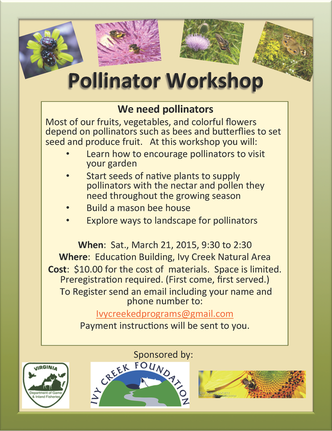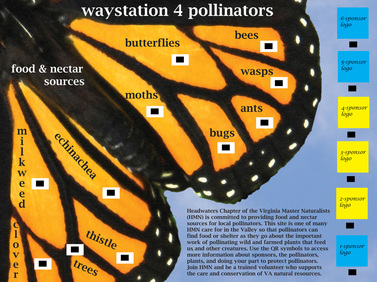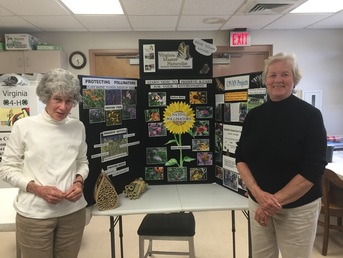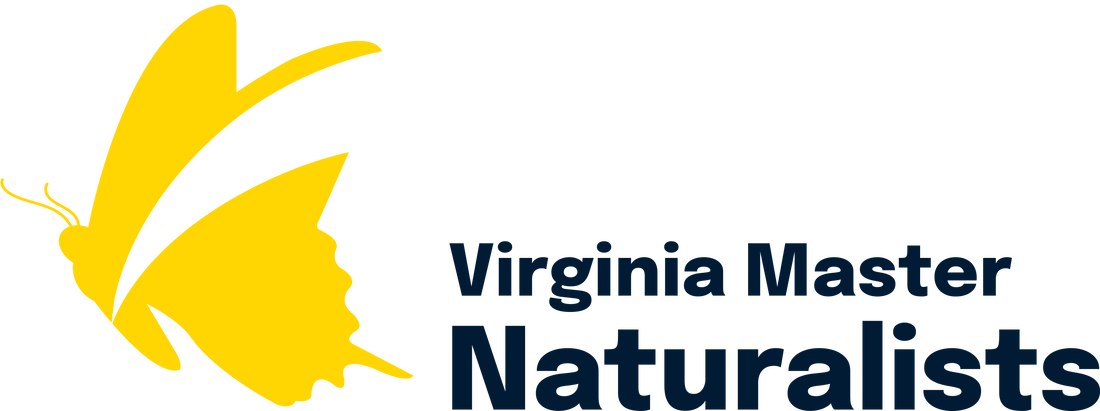 Flyer from pollinator workshop put on by Rivanna Chapter volunteers.
Flyer from pollinator workshop put on by Rivanna Chapter volunteers. By Karen L. Mulder (VMN trainee, Rivanna Chapter, class of 2015)
Heading into Spring, our area hosted several events that inspired great participation and excitement in the pollinator sphere. “I think the awareness has skyrocketed,” Chesapeake Wildlife Heritage’s Austin Jamison recently commented, welcoming interactions with the public about native plants, pollinators, bee friendly landscaping, and how to establish pollinator meadows in particular.
At the Stonefire Station in Barboursville, on March 11, Jack Price (VMN volunteer, Old Rag Chapter) estimated that about 125 people attended a pollinator forum sponsored by the Dolly Madison Garden Club. Jack laid the groundwork by introducing the pollination process and the key pollinators involved, followed by Repp Glaettli’s (VMN volunteer, Rivanna Chapter) overview about the primary threats that native pollinators currently face. Then Don Hearl, President of the Old Rag MN chapter, concluded the program presentations with a talk about how to create habitat that attracts pollinators, pointing out differences between host and nectaring plants. Ann Harman, former president of the Virginia Bee Keepers Association, joined the group in a panel to field questions from the audience. As Jack reports, the response from the audience showed genuine interest in the topic, with particular focus on how habitat issues have impacted pollination in our area.
Tables representing the efforts of the Old Rag MNs, Culpeper Soil and Water Conservation District, and various vendors (such as a native plants nursery rep) participated as well, sharing the latest information on pesticides and the increasing use of neonicotinoids. Jack and other presenters felt that this forum benefited a huge number of individuals, and of course, he hopes to see the suggestions offered by the presenters come to fruition in the pollinators’ landscape. More of this, please!
Repp Glaettli and Ruth Douglas (VMN volunteer, Rivanna Chapter) contributed three hour talks for the Louisa Master Gardeners at the Louisa Public Library in March, as part of a month-long series titled “Piedmont Native Plants: A Guide for Gardens and Landscapes.” Repp focused on native plants and offers a digital draft to anyone interested that explains which insects play vital roles in our area; just ask him for a copy at [email protected]. Botanist Ruth Douglas, an indefatigable booster for native plants from the Rivanna MN chapter, spoke about the pollinator exchange.
Mary Lee Epps described another well-attended forum at the Ivy Creek Natural Area with Rivanna Master Naturalist Marilyn Smith and Austin Jamison, on March 21. “Marilyn and I had both attended a ‘Train the Trainer’ workshop on pollinators put on by Carol Heiser with VDGIF (the Virginia Department of Game and Inland Fisheries) and Nancy Adamson of the Xerxes Foundation,” she says. “Carol supplied us with a large number of free brochures and handouts to give attendees. We tried to combine information with hands-on-activities, and people seemed to really enjoy the day.”
The Ivy Creek event began with a general presentation introducing and offering suggestions about how to construct pollinator gardens featuring native plants. Marilyn demonstrated how to construct mason bee houses, using pre-made frames created by her and her husband, and inviting participants to cut bamboo for nest tunnels. Her accompanying Powerpoint described the lives and habits of mason and leafcutter bees. Austin Jamison, from the Blue Ridge Division of Chesapeake Wildlife Heritage, addressed the main activities involved in planting a pollinator meadow, including how to prepare a site, which planting techniques work best, how to maintain such meadows, which seed mixes flourish in our area, and what the meadow tender can realistically expect.
After lunch, attendees divided into four working groups and tackled the challenges of designing pollinator gardens in four particular and realistic scenarios. One involved a 10 x 60’ private vegetable garden in an urban/suburban environment, with the owner asking for better yields and a more attractive appearance; another provided a homebuilder’s plot, cleared for construction, that called for environmentally responsible landscaping solutions. The third group posed as owners of a local garden center that services urban/suburban clients, but is adding more native plants to its inventory. How could they create a new entrance that would educate and inform clients about the need and splendor of native flora? The final project focused on Washington Park, or any urban park, and the opportunity to improve a pollinator habitat in the midst of a heavily used site of particular cultural importance to a largely African-American neighborhood.
Each group shared their solutions at the end of the workshop, and as a final activity, participants potted pre-stratified seeds of pollinator-friendly native plants. As a takeaway, everyone went home with a mason bee house and eight or ten pots of native plants. Mary Lee Epps mentioned, in passing, that each participant paid $10 to defray the cost of materials, potting soils and seeds (pots were donated!), but that charging this modest amount, in her opinion, also helped the attendees take the event and its message seriously. All good!
Heading into Spring, our area hosted several events that inspired great participation and excitement in the pollinator sphere. “I think the awareness has skyrocketed,” Chesapeake Wildlife Heritage’s Austin Jamison recently commented, welcoming interactions with the public about native plants, pollinators, bee friendly landscaping, and how to establish pollinator meadows in particular.
At the Stonefire Station in Barboursville, on March 11, Jack Price (VMN volunteer, Old Rag Chapter) estimated that about 125 people attended a pollinator forum sponsored by the Dolly Madison Garden Club. Jack laid the groundwork by introducing the pollination process and the key pollinators involved, followed by Repp Glaettli’s (VMN volunteer, Rivanna Chapter) overview about the primary threats that native pollinators currently face. Then Don Hearl, President of the Old Rag MN chapter, concluded the program presentations with a talk about how to create habitat that attracts pollinators, pointing out differences between host and nectaring plants. Ann Harman, former president of the Virginia Bee Keepers Association, joined the group in a panel to field questions from the audience. As Jack reports, the response from the audience showed genuine interest in the topic, with particular focus on how habitat issues have impacted pollination in our area.
Tables representing the efforts of the Old Rag MNs, Culpeper Soil and Water Conservation District, and various vendors (such as a native plants nursery rep) participated as well, sharing the latest information on pesticides and the increasing use of neonicotinoids. Jack and other presenters felt that this forum benefited a huge number of individuals, and of course, he hopes to see the suggestions offered by the presenters come to fruition in the pollinators’ landscape. More of this, please!
Repp Glaettli and Ruth Douglas (VMN volunteer, Rivanna Chapter) contributed three hour talks for the Louisa Master Gardeners at the Louisa Public Library in March, as part of a month-long series titled “Piedmont Native Plants: A Guide for Gardens and Landscapes.” Repp focused on native plants and offers a digital draft to anyone interested that explains which insects play vital roles in our area; just ask him for a copy at [email protected]. Botanist Ruth Douglas, an indefatigable booster for native plants from the Rivanna MN chapter, spoke about the pollinator exchange.
Mary Lee Epps described another well-attended forum at the Ivy Creek Natural Area with Rivanna Master Naturalist Marilyn Smith and Austin Jamison, on March 21. “Marilyn and I had both attended a ‘Train the Trainer’ workshop on pollinators put on by Carol Heiser with VDGIF (the Virginia Department of Game and Inland Fisheries) and Nancy Adamson of the Xerxes Foundation,” she says. “Carol supplied us with a large number of free brochures and handouts to give attendees. We tried to combine information with hands-on-activities, and people seemed to really enjoy the day.”
The Ivy Creek event began with a general presentation introducing and offering suggestions about how to construct pollinator gardens featuring native plants. Marilyn demonstrated how to construct mason bee houses, using pre-made frames created by her and her husband, and inviting participants to cut bamboo for nest tunnels. Her accompanying Powerpoint described the lives and habits of mason and leafcutter bees. Austin Jamison, from the Blue Ridge Division of Chesapeake Wildlife Heritage, addressed the main activities involved in planting a pollinator meadow, including how to prepare a site, which planting techniques work best, how to maintain such meadows, which seed mixes flourish in our area, and what the meadow tender can realistically expect.
After lunch, attendees divided into four working groups and tackled the challenges of designing pollinator gardens in four particular and realistic scenarios. One involved a 10 x 60’ private vegetable garden in an urban/suburban environment, with the owner asking for better yields and a more attractive appearance; another provided a homebuilder’s plot, cleared for construction, that called for environmentally responsible landscaping solutions. The third group posed as owners of a local garden center that services urban/suburban clients, but is adding more native plants to its inventory. How could they create a new entrance that would educate and inform clients about the need and splendor of native flora? The final project focused on Washington Park, or any urban park, and the opportunity to improve a pollinator habitat in the midst of a heavily used site of particular cultural importance to a largely African-American neighborhood.
Each group shared their solutions at the end of the workshop, and as a final activity, participants potted pre-stratified seeds of pollinator-friendly native plants. As a takeaway, everyone went home with a mason bee house and eight or ten pots of native plants. Mary Lee Epps mentioned, in passing, that each participant paid $10 to defray the cost of materials, potting soils and seeds (pots were donated!), but that charging this modest amount, in her opinion, also helped the attendees take the event and its message seriously. All good!
 One of several draft versions for the interpretive signs the Headwaters Chapter is designing to accompany their Pollinator Waystations.
One of several draft versions for the interpretive signs the Headwaters Chapter is designing to accompany their Pollinator Waystations. The Headwaters MN Chapter is focusing for an entire year on pollinators, planning and planting pollinator gardens at several locations in their area, and also doing educational projects associated with these sites. Working in teams, and with graphic designers and sign manufacturers, Sandy Greene and her group have researched the contents, ‘look’, and placement of beautiful pollinator awareness signs, which you can view in the design stage at http://headwatersmn.org/category/projects/focus-project-20142015. The compelling factor in all this is that the HMN is engaging with sponsors and park managers in the process of creating and placing the durable metal signs, and tasking the site owners with the responsibility for installing them, engendering a certain level of commitment for pollinator awareness. As Sandy explained in April, “We have been in the process of planting in all kinds of native perennials (milkweed already in). We’ll be adding annuals mid-May, signs and plant markers in June. Each of the five ‘way stations’ for pollinators involves different teams, different parks or public lands managers, and different designs in a variety of environments. We have committed to establishing and maintaining the program for the next two years.” On August 15th, the chapter will arrange a bus tour to showoff the results. You go, folks! Sounds like a great initiative.
Coming up this summer, Dr. Jessica Rykken, an entomologist from Harvard University’s Farrell Lab and Museum of Comparative Zoology, will conduct a concerted pollinators’ survey in Shenandoah National Park, and has cast a wide net to Virginian Master Naturalists who may want to help. “What I hope to accomplish with help from volunteers is to run transects of ‘bee bowls,’” Jessica explains, “one day a month, at selected areas along the length of Skyline Drive, between May and October. Bee bowls are small plastic, painted cups, laid out in lines of 30 (spaced five millimeters apart), filled with soapy water, and left out for 6 to 8 hours on warm, sunny days… The protocol is very simple, and can only be done in nice weather! I had great success with VMNs in the past, doing something similar at George Washington Birthplace NM.” The response to what will be, for her, a fairly complicated feat of coordination, has already been enthusiastic, Jessica has noted. If you are interested in this project, please contact her at [email protected].
Coming up this summer, Dr. Jessica Rykken, an entomologist from Harvard University’s Farrell Lab and Museum of Comparative Zoology, will conduct a concerted pollinators’ survey in Shenandoah National Park, and has cast a wide net to Virginian Master Naturalists who may want to help. “What I hope to accomplish with help from volunteers is to run transects of ‘bee bowls,’” Jessica explains, “one day a month, at selected areas along the length of Skyline Drive, between May and October. Bee bowls are small plastic, painted cups, laid out in lines of 30 (spaced five millimeters apart), filled with soapy water, and left out for 6 to 8 hours on warm, sunny days… The protocol is very simple, and can only be done in nice weather! I had great success with VMNs in the past, doing something similar at George Washington Birthplace NM.” The response to what will be, for her, a fairly complicated feat of coordination, has already been enthusiastic, Jessica has noted. If you are interested in this project, please contact her at [email protected].
 Central Piedmont Master Naturalist volunteers with a display on pollinators that they are sharing at several local festivals and community events.
Central Piedmont Master Naturalist volunteers with a display on pollinators that they are sharing at several local festivals and community events. There has been tremendous vitality shown on the part of so many Virginia Master Naturalist chapters focused on pollinator projects—for example, both the Northern Neck and Central Piedmont chapters have designed educational displays to spread the word, and the VDGIF and USDA-NRCS held a Habitat Training Workshop for Rivanna MNs interested in helping with the Pollinator Garden Project on Earth Day at Pleasant Grove Park, which filled up quickly. There is much more going on than we could possibly marshal together in this brief overview, which is a good thing! Write us if you have something to contribute!
And that’s what’s buzzing.
And that’s what’s buzzing.


 RSS Feed
RSS Feed